University Report: IoT Technology in Emergency Response Operations
VerifiedAdded on 2022/10/09
|11
|2913
|17
Report
AI Summary
This report delves into the application of Internet of Things (IoT) technology to enhance emergency response operations. It begins with a literature review, exploring the benefits of IoT in disaster management, including improved situational awareness, efficient resource allocation, and better communication infrastructure. The methodology section outlines the research approach, which involves analyzing existing studies and considering the use of various data collection methods, including primary and secondary sources. The report emphasizes the importance of IoT in detecting disasters, mitigating risks, and providing effective aid during emergencies. It highlights the role of wireless sensor networks, smart devices, and data analysis in improving public safety and response times. The research also focuses on ethical considerations and potential limitations associated with the implementation of IoT in emergency response scenarios. Overall, the report provides a comprehensive overview of how IoT can revolutionize emergency management practices.
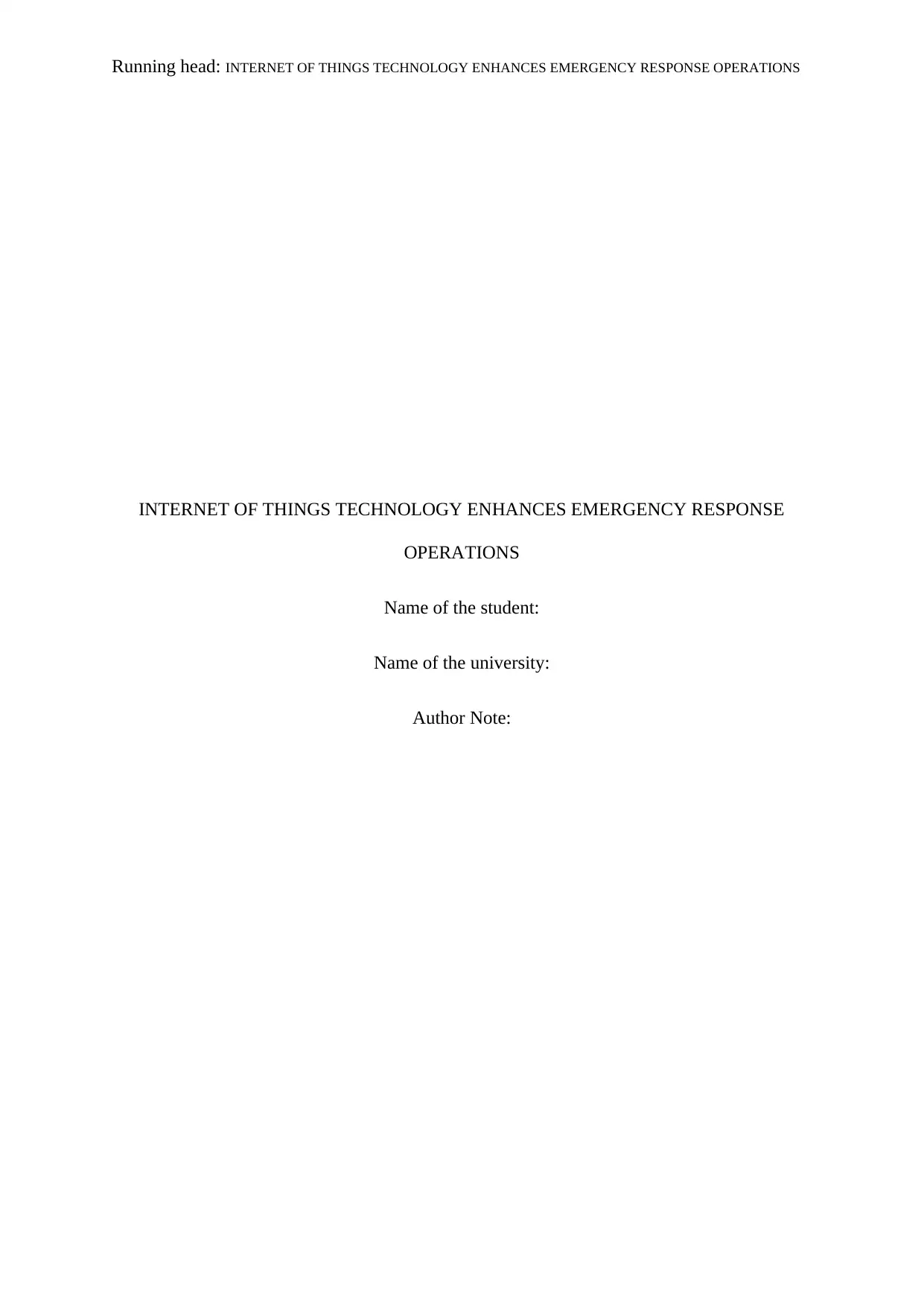
Running head: INTERNET OF THINGS TECHNOLOGY ENHANCES EMERGENCY RESPONSE OPERATIONS
INTERNET OF THINGS TECHNOLOGY ENHANCES EMERGENCY RESPONSE
OPERATIONS
Name of the student:
Name of the university:
Author Note:
INTERNET OF THINGS TECHNOLOGY ENHANCES EMERGENCY RESPONSE
OPERATIONS
Name of the student:
Name of the university:
Author Note:
Paraphrase This Document
Need a fresh take? Get an instant paraphrase of this document with our AI Paraphraser
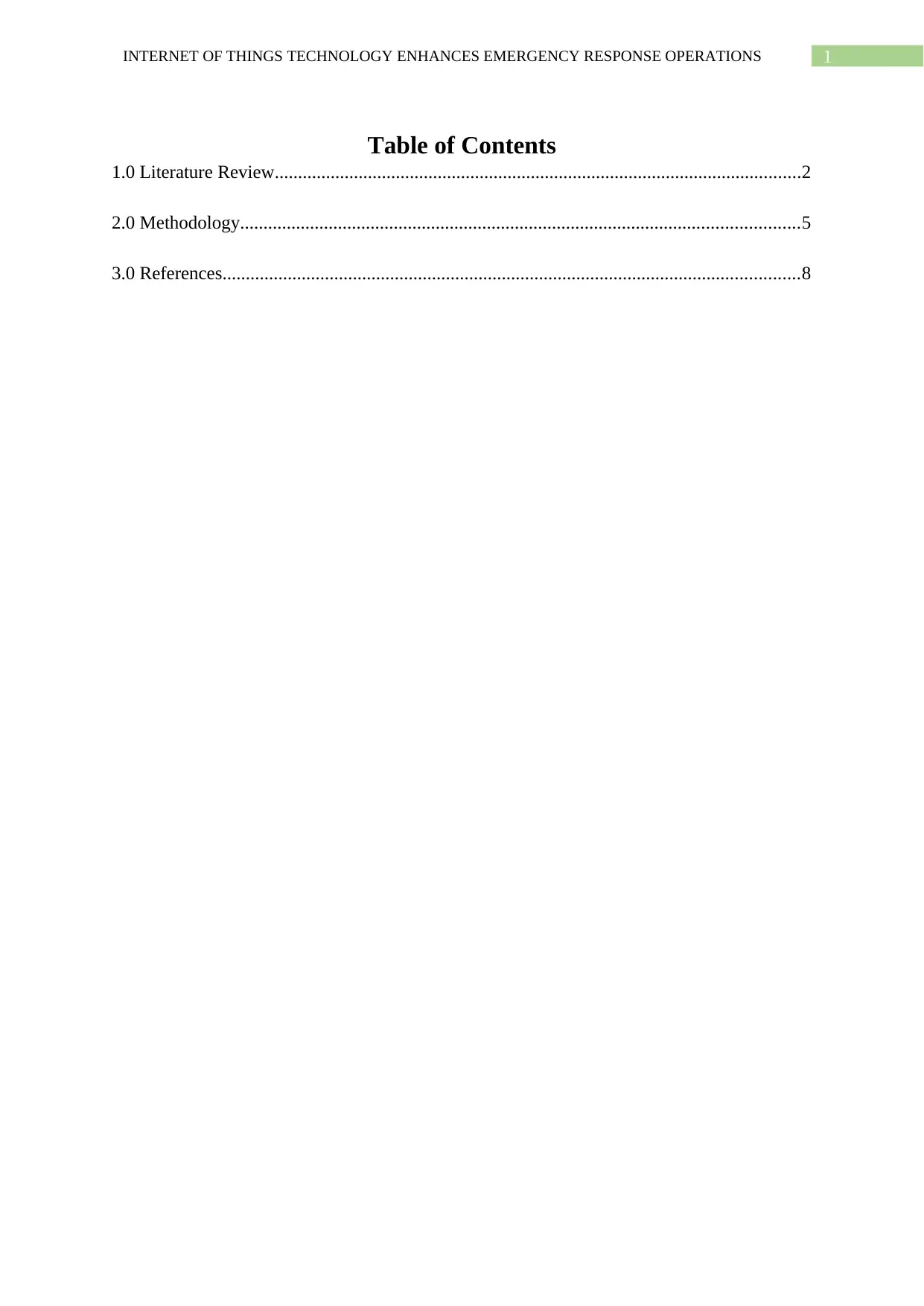
1INTERNET OF THINGS TECHNOLOGY ENHANCES EMERGENCY RESPONSE OPERATIONS
Table of Contents
1.0 Literature Review.................................................................................................................2
2.0 Methodology........................................................................................................................5
3.0 References............................................................................................................................8
Table of Contents
1.0 Literature Review.................................................................................................................2
2.0 Methodology........................................................................................................................5
3.0 References............................................................................................................................8
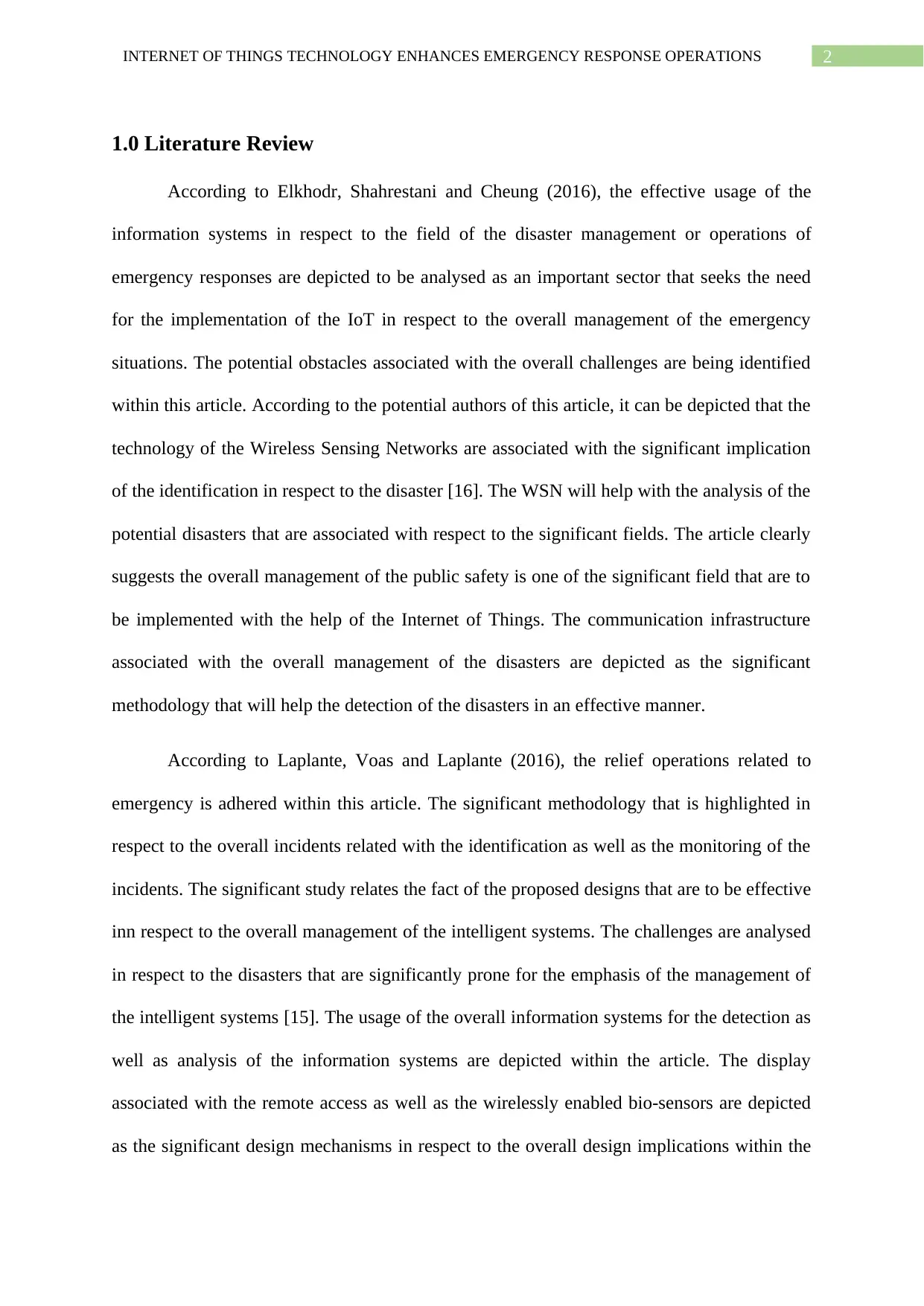
2INTERNET OF THINGS TECHNOLOGY ENHANCES EMERGENCY RESPONSE OPERATIONS
1.0 Literature Review
According to Elkhodr, Shahrestani and Cheung (2016), the effective usage of the
information systems in respect to the field of the disaster management or operations of
emergency responses are depicted to be analysed as an important sector that seeks the need
for the implementation of the IoT in respect to the overall management of the emergency
situations. The potential obstacles associated with the overall challenges are being identified
within this article. According to the potential authors of this article, it can be depicted that the
technology of the Wireless Sensing Networks are associated with the significant implication
of the identification in respect to the disaster [16]. The WSN will help with the analysis of the
potential disasters that are associated with respect to the significant fields. The article clearly
suggests the overall management of the public safety is one of the significant field that are to
be implemented with the help of the Internet of Things. The communication infrastructure
associated with the overall management of the disasters are depicted as the significant
methodology that will help the detection of the disasters in an effective manner.
According to Laplante, Voas and Laplante (2016), the relief operations related to
emergency is adhered within this article. The significant methodology that is highlighted in
respect to the overall incidents related with the identification as well as the monitoring of the
incidents. The significant study relates the fact of the proposed designs that are to be effective
inn respect to the overall management of the intelligent systems. The challenges are analysed
in respect to the disasters that are significantly prone for the emphasis of the management of
the intelligent systems [15]. The usage of the overall information systems for the detection as
well as analysis of the information systems are depicted within the article. The display
associated with the remote access as well as the wirelessly enabled bio-sensors are depicted
as the significant design mechanisms in respect to the overall design implications within the
1.0 Literature Review
According to Elkhodr, Shahrestani and Cheung (2016), the effective usage of the
information systems in respect to the field of the disaster management or operations of
emergency responses are depicted to be analysed as an important sector that seeks the need
for the implementation of the IoT in respect to the overall management of the emergency
situations. The potential obstacles associated with the overall challenges are being identified
within this article. According to the potential authors of this article, it can be depicted that the
technology of the Wireless Sensing Networks are associated with the significant implication
of the identification in respect to the disaster [16]. The WSN will help with the analysis of the
potential disasters that are associated with respect to the significant fields. The article clearly
suggests the overall management of the public safety is one of the significant field that are to
be implemented with the help of the Internet of Things. The communication infrastructure
associated with the overall management of the disasters are depicted as the significant
methodology that will help the detection of the disasters in an effective manner.
According to Laplante, Voas and Laplante (2016), the relief operations related to
emergency is adhered within this article. The significant methodology that is highlighted in
respect to the overall incidents related with the identification as well as the monitoring of the
incidents. The significant study relates the fact of the proposed designs that are to be effective
inn respect to the overall management of the intelligent systems. The challenges are analysed
in respect to the disasters that are significantly prone for the emphasis of the management of
the intelligent systems [15]. The usage of the overall information systems for the detection as
well as analysis of the information systems are depicted within the article. The display
associated with the remote access as well as the wirelessly enabled bio-sensors are depicted
as the significant design mechanisms in respect to the overall design implications within the
⊘ This is a preview!⊘
Do you want full access?
Subscribe today to unlock all pages.

Trusted by 1+ million students worldwide
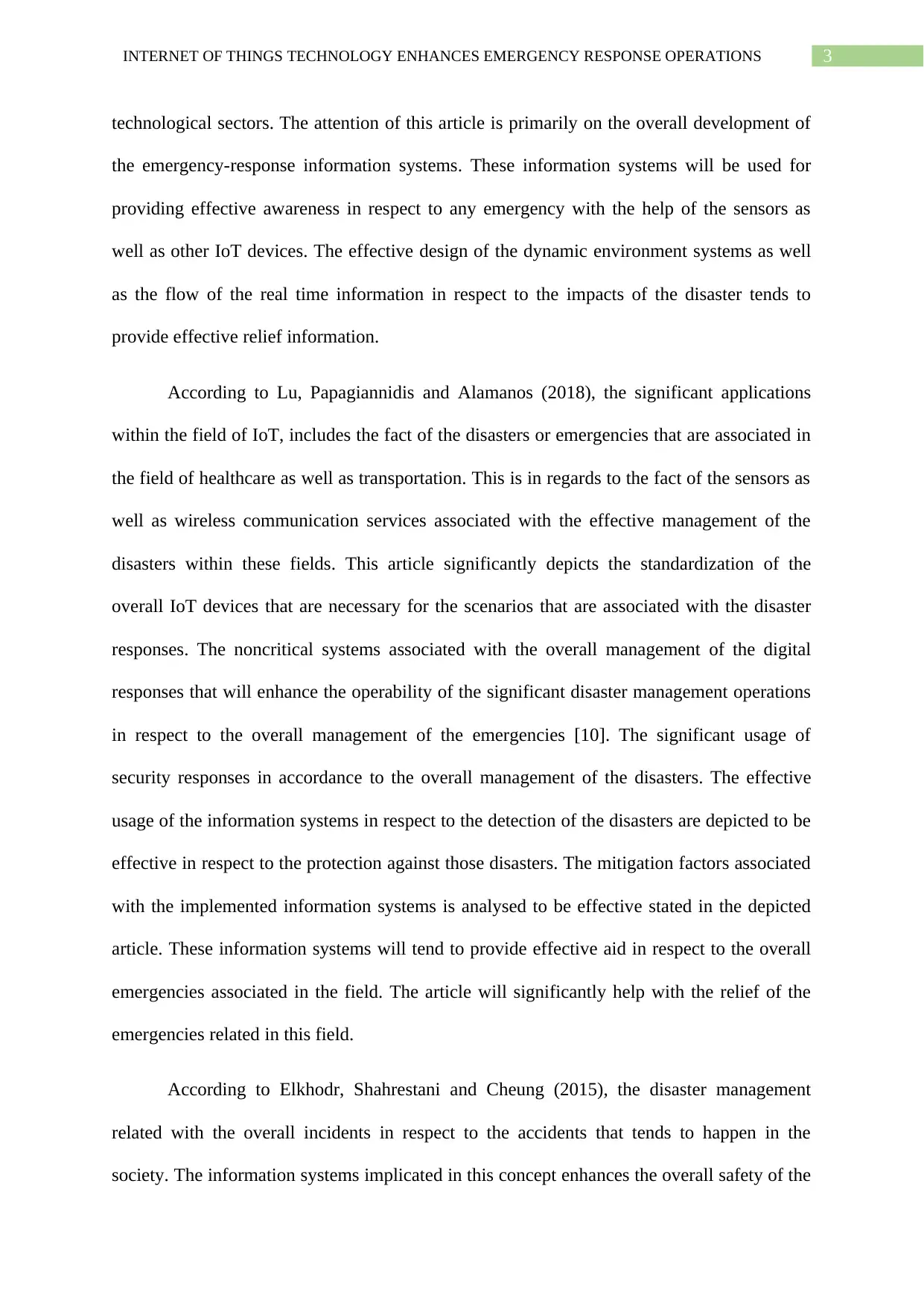
3INTERNET OF THINGS TECHNOLOGY ENHANCES EMERGENCY RESPONSE OPERATIONS
technological sectors. The attention of this article is primarily on the overall development of
the emergency-response information systems. These information systems will be used for
providing effective awareness in respect to any emergency with the help of the sensors as
well as other IoT devices. The effective design of the dynamic environment systems as well
as the flow of the real time information in respect to the impacts of the disaster tends to
provide effective relief information.
According to Lu, Papagiannidis and Alamanos (2018), the significant applications
within the field of IoT, includes the fact of the disasters or emergencies that are associated in
the field of healthcare as well as transportation. This is in regards to the fact of the sensors as
well as wireless communication services associated with the effective management of the
disasters within these fields. This article significantly depicts the standardization of the
overall IoT devices that are necessary for the scenarios that are associated with the disaster
responses. The noncritical systems associated with the overall management of the digital
responses that will enhance the operability of the significant disaster management operations
in respect to the overall management of the emergencies [10]. The significant usage of
security responses in accordance to the overall management of the disasters. The effective
usage of the information systems in respect to the detection of the disasters are depicted to be
effective in respect to the protection against those disasters. The mitigation factors associated
with the implemented information systems is analysed to be effective stated in the depicted
article. These information systems will tend to provide effective aid in respect to the overall
emergencies associated in the field. The article will significantly help with the relief of the
emergencies related in this field.
According to Elkhodr, Shahrestani and Cheung (2015), the disaster management
related with the overall incidents in respect to the accidents that tends to happen in the
society. The information systems implicated in this concept enhances the overall safety of the
technological sectors. The attention of this article is primarily on the overall development of
the emergency-response information systems. These information systems will be used for
providing effective awareness in respect to any emergency with the help of the sensors as
well as other IoT devices. The effective design of the dynamic environment systems as well
as the flow of the real time information in respect to the impacts of the disaster tends to
provide effective relief information.
According to Lu, Papagiannidis and Alamanos (2018), the significant applications
within the field of IoT, includes the fact of the disasters or emergencies that are associated in
the field of healthcare as well as transportation. This is in regards to the fact of the sensors as
well as wireless communication services associated with the effective management of the
disasters within these fields. This article significantly depicts the standardization of the
overall IoT devices that are necessary for the scenarios that are associated with the disaster
responses. The noncritical systems associated with the overall management of the digital
responses that will enhance the operability of the significant disaster management operations
in respect to the overall management of the emergencies [10]. The significant usage of
security responses in accordance to the overall management of the disasters. The effective
usage of the information systems in respect to the detection of the disasters are depicted to be
effective in respect to the protection against those disasters. The mitigation factors associated
with the implemented information systems is analysed to be effective stated in the depicted
article. These information systems will tend to provide effective aid in respect to the overall
emergencies associated in the field. The article will significantly help with the relief of the
emergencies related in this field.
According to Elkhodr, Shahrestani and Cheung (2015), the disaster management
related with the overall incidents in respect to the accidents that tends to happen in the
society. The information systems implicated in this concept enhances the overall safety of the
Paraphrase This Document
Need a fresh take? Get an instant paraphrase of this document with our AI Paraphraser
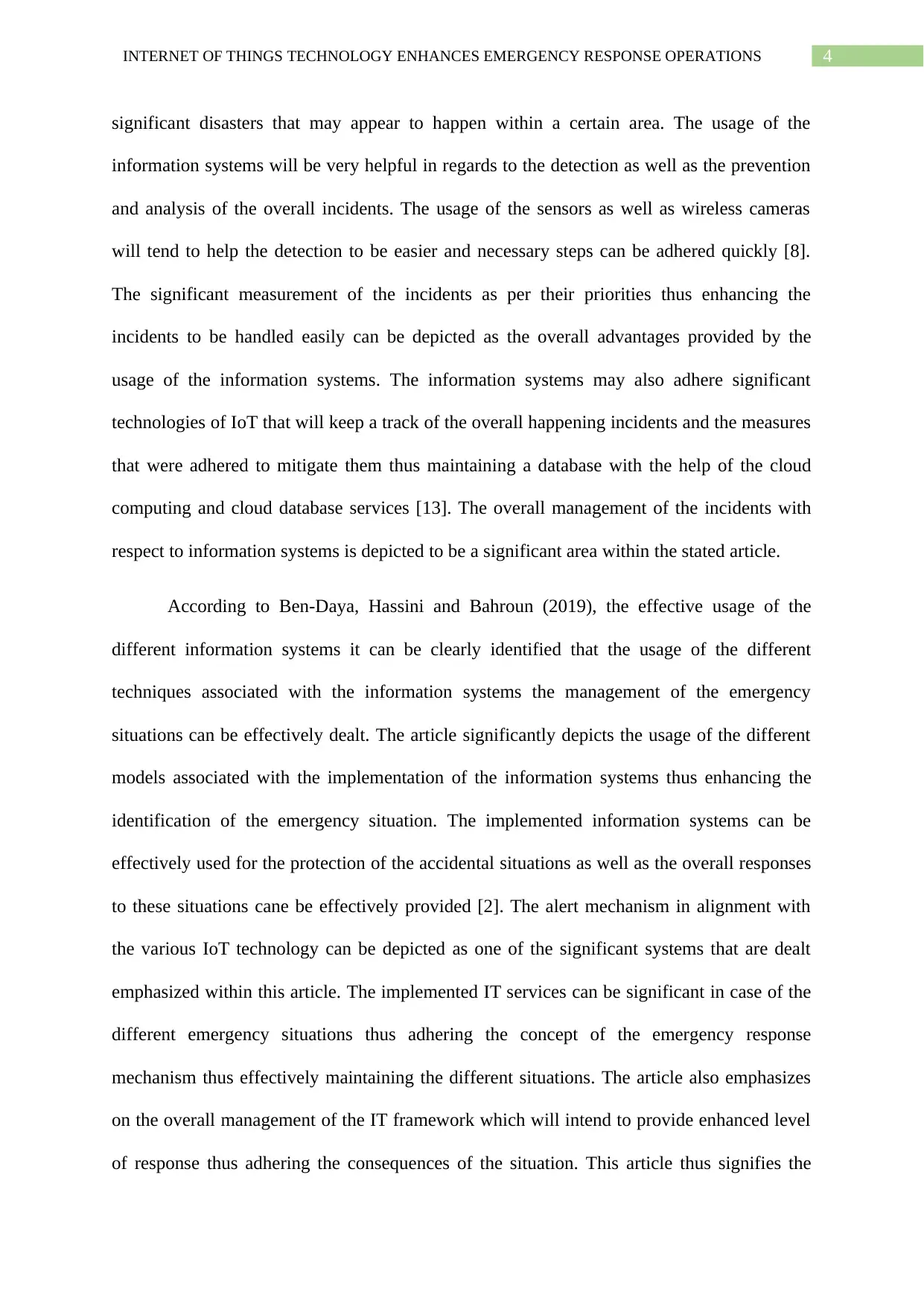
4INTERNET OF THINGS TECHNOLOGY ENHANCES EMERGENCY RESPONSE OPERATIONS
significant disasters that may appear to happen within a certain area. The usage of the
information systems will be very helpful in regards to the detection as well as the prevention
and analysis of the overall incidents. The usage of the sensors as well as wireless cameras
will tend to help the detection to be easier and necessary steps can be adhered quickly [8].
The significant measurement of the incidents as per their priorities thus enhancing the
incidents to be handled easily can be depicted as the overall advantages provided by the
usage of the information systems. The information systems may also adhere significant
technologies of IoT that will keep a track of the overall happening incidents and the measures
that were adhered to mitigate them thus maintaining a database with the help of the cloud
computing and cloud database services [13]. The overall management of the incidents with
respect to information systems is depicted to be a significant area within the stated article.
According to Ben-Daya, Hassini and Bahroun (2019), the effective usage of the
different information systems it can be clearly identified that the usage of the different
techniques associated with the information systems the management of the emergency
situations can be effectively dealt. The article significantly depicts the usage of the different
models associated with the implementation of the information systems thus enhancing the
identification of the emergency situation. The implemented information systems can be
effectively used for the protection of the accidental situations as well as the overall responses
to these situations cane be effectively provided [2]. The alert mechanism in alignment with
the various IoT technology can be depicted as one of the significant systems that are dealt
emphasized within this article. The implemented IT services can be significant in case of the
different emergency situations thus adhering the concept of the emergency response
mechanism thus effectively maintaining the different situations. The article also emphasizes
on the overall management of the IT framework which will intend to provide enhanced level
of response thus adhering the consequences of the situation. This article thus signifies the
significant disasters that may appear to happen within a certain area. The usage of the
information systems will be very helpful in regards to the detection as well as the prevention
and analysis of the overall incidents. The usage of the sensors as well as wireless cameras
will tend to help the detection to be easier and necessary steps can be adhered quickly [8].
The significant measurement of the incidents as per their priorities thus enhancing the
incidents to be handled easily can be depicted as the overall advantages provided by the
usage of the information systems. The information systems may also adhere significant
technologies of IoT that will keep a track of the overall happening incidents and the measures
that were adhered to mitigate them thus maintaining a database with the help of the cloud
computing and cloud database services [13]. The overall management of the incidents with
respect to information systems is depicted to be a significant area within the stated article.
According to Ben-Daya, Hassini and Bahroun (2019), the effective usage of the
different information systems it can be clearly identified that the usage of the different
techniques associated with the information systems the management of the emergency
situations can be effectively dealt. The article significantly depicts the usage of the different
models associated with the implementation of the information systems thus enhancing the
identification of the emergency situation. The implemented information systems can be
effectively used for the protection of the accidental situations as well as the overall responses
to these situations cane be effectively provided [2]. The alert mechanism in alignment with
the various IoT technology can be depicted as one of the significant systems that are dealt
emphasized within this article. The implemented IT services can be significant in case of the
different emergency situations thus adhering the concept of the emergency response
mechanism thus effectively maintaining the different situations. The article also emphasizes
on the overall management of the IT framework which will intend to provide enhanced level
of response thus adhering the consequences of the situation. This article thus signifies the
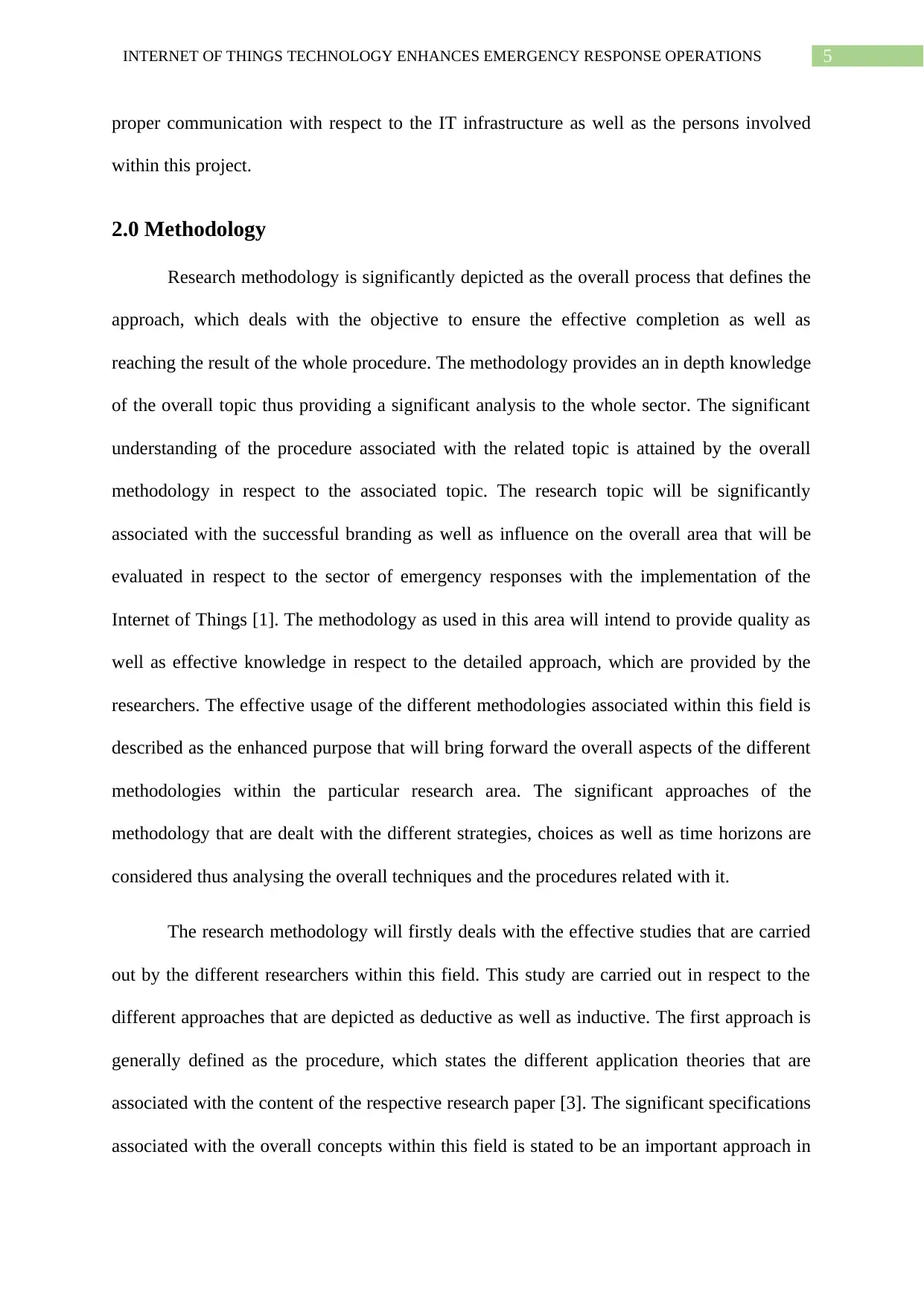
5INTERNET OF THINGS TECHNOLOGY ENHANCES EMERGENCY RESPONSE OPERATIONS
proper communication with respect to the IT infrastructure as well as the persons involved
within this project.
2.0 Methodology
Research methodology is significantly depicted as the overall process that defines the
approach, which deals with the objective to ensure the effective completion as well as
reaching the result of the whole procedure. The methodology provides an in depth knowledge
of the overall topic thus providing a significant analysis to the whole sector. The significant
understanding of the procedure associated with the related topic is attained by the overall
methodology in respect to the associated topic. The research topic will be significantly
associated with the successful branding as well as influence on the overall area that will be
evaluated in respect to the sector of emergency responses with the implementation of the
Internet of Things [1]. The methodology as used in this area will intend to provide quality as
well as effective knowledge in respect to the detailed approach, which are provided by the
researchers. The effective usage of the different methodologies associated within this field is
described as the enhanced purpose that will bring forward the overall aspects of the different
methodologies within the particular research area. The significant approaches of the
methodology that are dealt with the different strategies, choices as well as time horizons are
considered thus analysing the overall techniques and the procedures related with it.
The research methodology will firstly deals with the effective studies that are carried
out by the different researchers within this field. This study are carried out in respect to the
different approaches that are depicted as deductive as well as inductive. The first approach is
generally defined as the procedure, which states the different application theories that are
associated with the content of the respective research paper [3]. The significant specifications
associated with the overall concepts within this field is stated to be an important approach in
proper communication with respect to the IT infrastructure as well as the persons involved
within this project.
2.0 Methodology
Research methodology is significantly depicted as the overall process that defines the
approach, which deals with the objective to ensure the effective completion as well as
reaching the result of the whole procedure. The methodology provides an in depth knowledge
of the overall topic thus providing a significant analysis to the whole sector. The significant
understanding of the procedure associated with the related topic is attained by the overall
methodology in respect to the associated topic. The research topic will be significantly
associated with the successful branding as well as influence on the overall area that will be
evaluated in respect to the sector of emergency responses with the implementation of the
Internet of Things [1]. The methodology as used in this area will intend to provide quality as
well as effective knowledge in respect to the detailed approach, which are provided by the
researchers. The effective usage of the different methodologies associated within this field is
described as the enhanced purpose that will bring forward the overall aspects of the different
methodologies within the particular research area. The significant approaches of the
methodology that are dealt with the different strategies, choices as well as time horizons are
considered thus analysing the overall techniques and the procedures related with it.
The research methodology will firstly deals with the effective studies that are carried
out by the different researchers within this field. This study are carried out in respect to the
different approaches that are depicted as deductive as well as inductive. The first approach is
generally defined as the procedure, which states the different application theories that are
associated with the content of the respective research paper [3]. The significant specifications
associated with the overall concepts within this field is stated to be an important approach in
⊘ This is a preview!⊘
Do you want full access?
Subscribe today to unlock all pages.

Trusted by 1+ million students worldwide
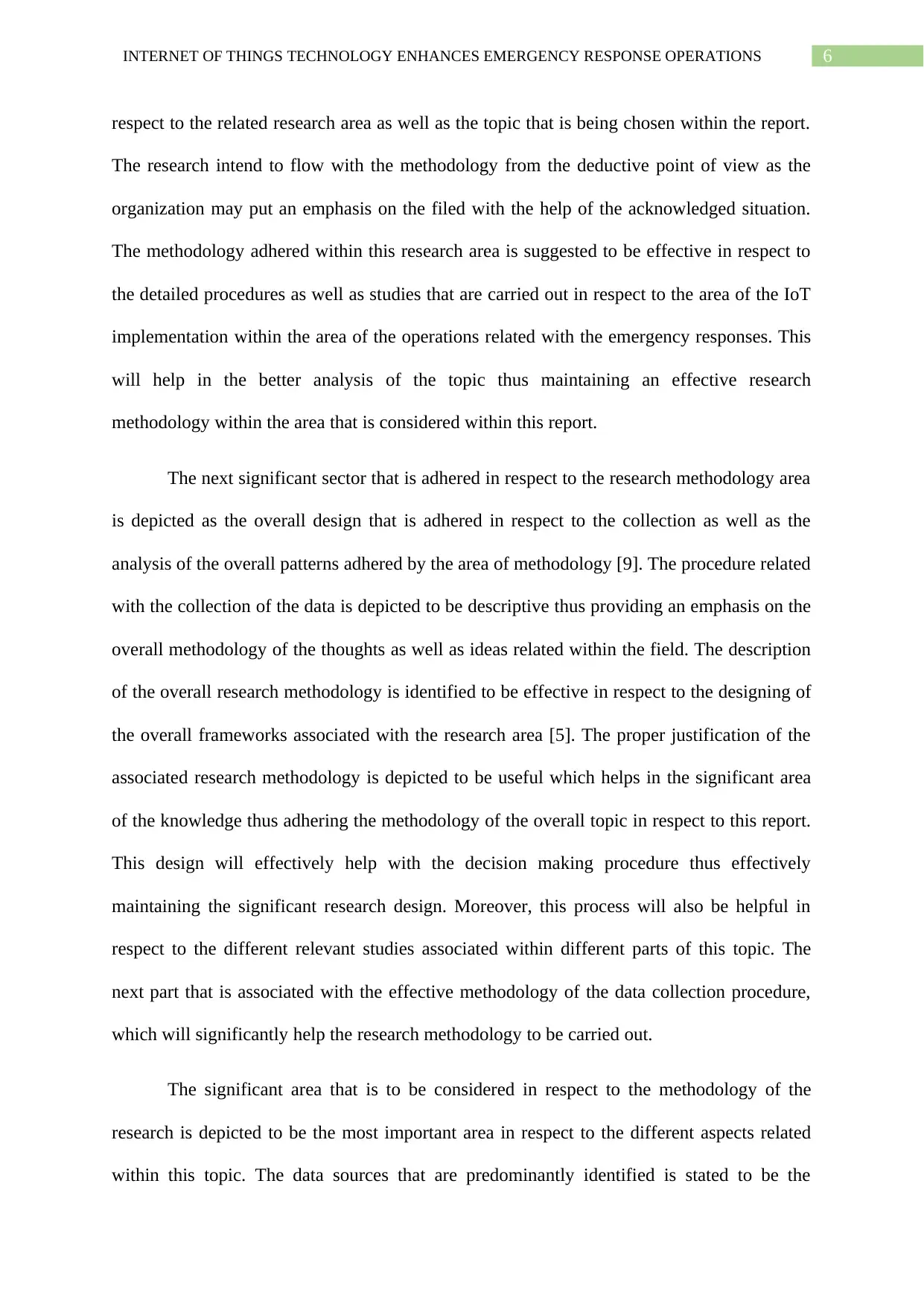
6INTERNET OF THINGS TECHNOLOGY ENHANCES EMERGENCY RESPONSE OPERATIONS
respect to the related research area as well as the topic that is being chosen within the report.
The research intend to flow with the methodology from the deductive point of view as the
organization may put an emphasis on the filed with the help of the acknowledged situation.
The methodology adhered within this research area is suggested to be effective in respect to
the detailed procedures as well as studies that are carried out in respect to the area of the IoT
implementation within the area of the operations related with the emergency responses. This
will help in the better analysis of the topic thus maintaining an effective research
methodology within the area that is considered within this report.
The next significant sector that is adhered in respect to the research methodology area
is depicted as the overall design that is adhered in respect to the collection as well as the
analysis of the overall patterns adhered by the area of methodology [9]. The procedure related
with the collection of the data is depicted to be descriptive thus providing an emphasis on the
overall methodology of the thoughts as well as ideas related within the field. The description
of the overall research methodology is identified to be effective in respect to the designing of
the overall frameworks associated with the research area [5]. The proper justification of the
associated research methodology is depicted to be useful which helps in the significant area
of the knowledge thus adhering the methodology of the overall topic in respect to this report.
This design will effectively help with the decision making procedure thus effectively
maintaining the significant research design. Moreover, this process will also be helpful in
respect to the different relevant studies associated within different parts of this topic. The
next part that is associated with the effective methodology of the data collection procedure,
which will significantly help the research methodology to be carried out.
The significant area that is to be considered in respect to the methodology of the
research is depicted to be the most important area in respect to the different aspects related
within this topic. The data sources that are predominantly identified is stated to be the
respect to the related research area as well as the topic that is being chosen within the report.
The research intend to flow with the methodology from the deductive point of view as the
organization may put an emphasis on the filed with the help of the acknowledged situation.
The methodology adhered within this research area is suggested to be effective in respect to
the detailed procedures as well as studies that are carried out in respect to the area of the IoT
implementation within the area of the operations related with the emergency responses. This
will help in the better analysis of the topic thus maintaining an effective research
methodology within the area that is considered within this report.
The next significant sector that is adhered in respect to the research methodology area
is depicted as the overall design that is adhered in respect to the collection as well as the
analysis of the overall patterns adhered by the area of methodology [9]. The procedure related
with the collection of the data is depicted to be descriptive thus providing an emphasis on the
overall methodology of the thoughts as well as ideas related within the field. The description
of the overall research methodology is identified to be effective in respect to the designing of
the overall frameworks associated with the research area [5]. The proper justification of the
associated research methodology is depicted to be useful which helps in the significant area
of the knowledge thus adhering the methodology of the overall topic in respect to this report.
This design will effectively help with the decision making procedure thus effectively
maintaining the significant research design. Moreover, this process will also be helpful in
respect to the different relevant studies associated within different parts of this topic. The
next part that is associated with the effective methodology of the data collection procedure,
which will significantly help the research methodology to be carried out.
The significant area that is to be considered in respect to the methodology of the
research is depicted to be the most important area in respect to the different aspects related
within this topic. The data sources that are predominantly identified is stated to be the
Paraphrase This Document
Need a fresh take? Get an instant paraphrase of this document with our AI Paraphraser
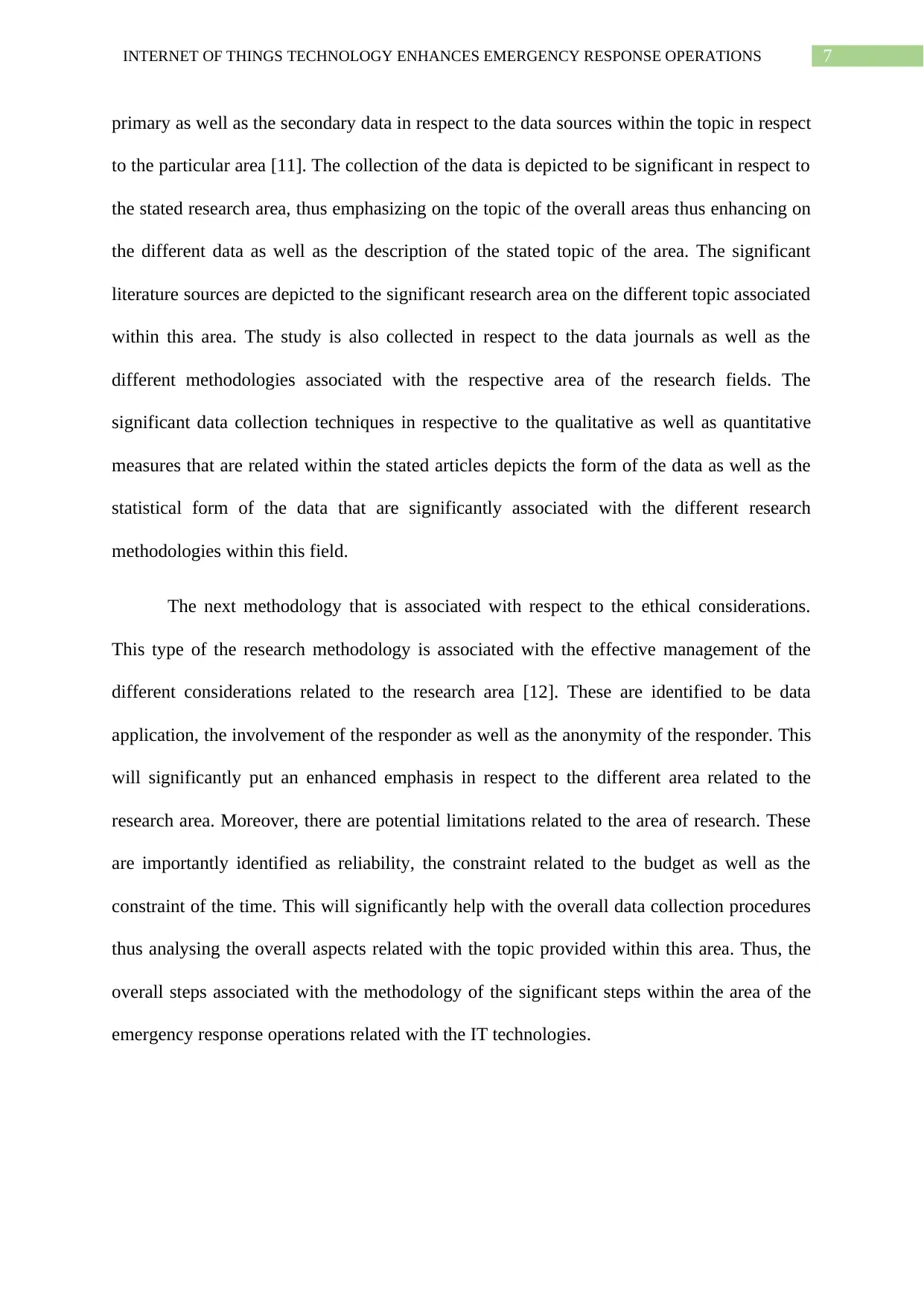
7INTERNET OF THINGS TECHNOLOGY ENHANCES EMERGENCY RESPONSE OPERATIONS
primary as well as the secondary data in respect to the data sources within the topic in respect
to the particular area [11]. The collection of the data is depicted to be significant in respect to
the stated research area, thus emphasizing on the topic of the overall areas thus enhancing on
the different data as well as the description of the stated topic of the area. The significant
literature sources are depicted to the significant research area on the different topic associated
within this area. The study is also collected in respect to the data journals as well as the
different methodologies associated with the respective area of the research fields. The
significant data collection techniques in respective to the qualitative as well as quantitative
measures that are related within the stated articles depicts the form of the data as well as the
statistical form of the data that are significantly associated with the different research
methodologies within this field.
The next methodology that is associated with respect to the ethical considerations.
This type of the research methodology is associated with the effective management of the
different considerations related to the research area [12]. These are identified to be data
application, the involvement of the responder as well as the anonymity of the responder. This
will significantly put an enhanced emphasis in respect to the different area related to the
research area. Moreover, there are potential limitations related to the area of research. These
are importantly identified as reliability, the constraint related to the budget as well as the
constraint of the time. This will significantly help with the overall data collection procedures
thus analysing the overall aspects related with the topic provided within this area. Thus, the
overall steps associated with the methodology of the significant steps within the area of the
emergency response operations related with the IT technologies.
primary as well as the secondary data in respect to the data sources within the topic in respect
to the particular area [11]. The collection of the data is depicted to be significant in respect to
the stated research area, thus emphasizing on the topic of the overall areas thus enhancing on
the different data as well as the description of the stated topic of the area. The significant
literature sources are depicted to the significant research area on the different topic associated
within this area. The study is also collected in respect to the data journals as well as the
different methodologies associated with the respective area of the research fields. The
significant data collection techniques in respective to the qualitative as well as quantitative
measures that are related within the stated articles depicts the form of the data as well as the
statistical form of the data that are significantly associated with the different research
methodologies within this field.
The next methodology that is associated with respect to the ethical considerations.
This type of the research methodology is associated with the effective management of the
different considerations related to the research area [12]. These are identified to be data
application, the involvement of the responder as well as the anonymity of the responder. This
will significantly put an enhanced emphasis in respect to the different area related to the
research area. Moreover, there are potential limitations related to the area of research. These
are importantly identified as reliability, the constraint related to the budget as well as the
constraint of the time. This will significantly help with the overall data collection procedures
thus analysing the overall aspects related with the topic provided within this area. Thus, the
overall steps associated with the methodology of the significant steps within the area of the
emergency response operations related with the IT technologies.
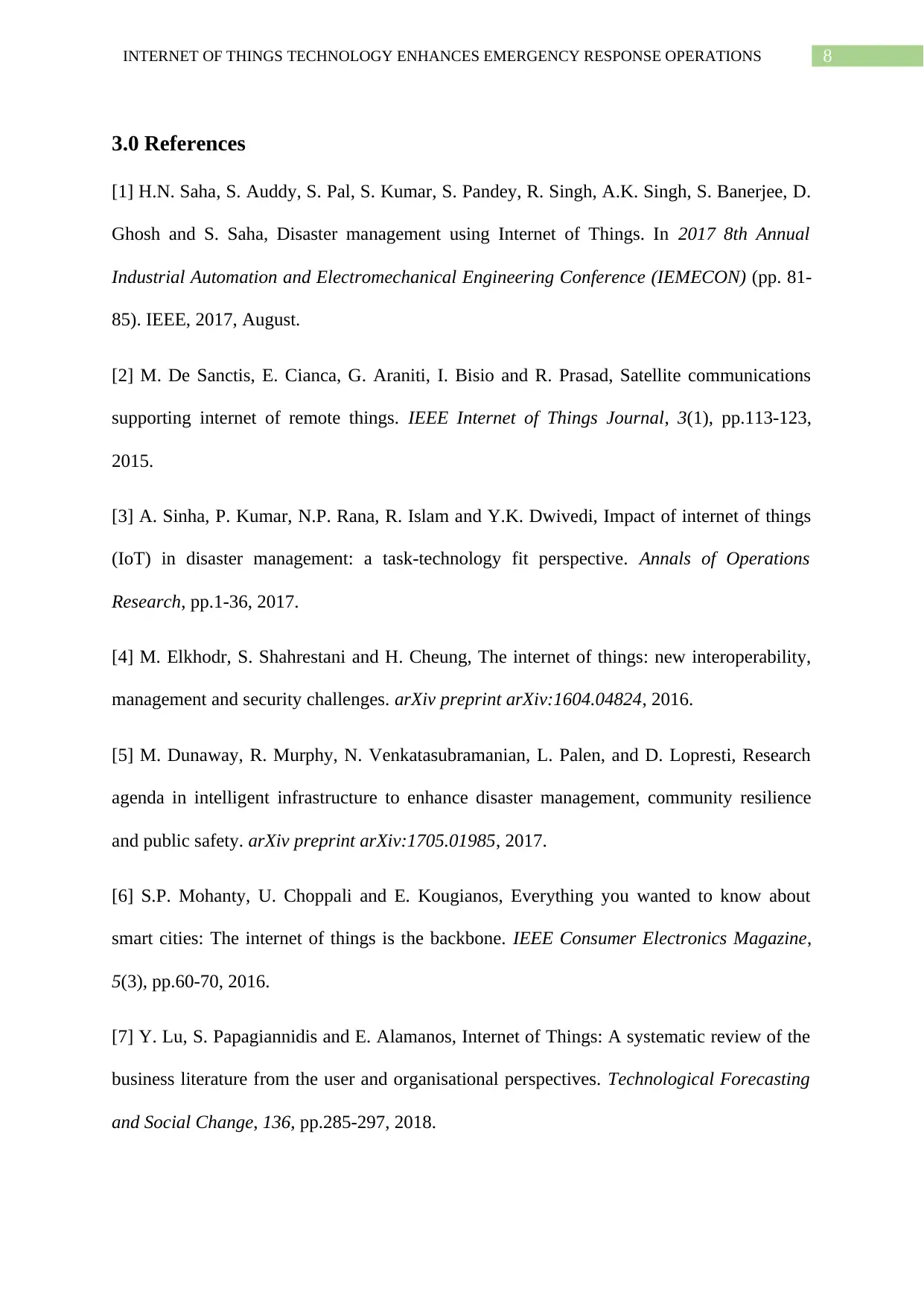
8INTERNET OF THINGS TECHNOLOGY ENHANCES EMERGENCY RESPONSE OPERATIONS
3.0 References
[1] H.N. Saha, S. Auddy, S. Pal, S. Kumar, S. Pandey, R. Singh, A.K. Singh, S. Banerjee, D.
Ghosh and S. Saha, Disaster management using Internet of Things. In 2017 8th Annual
Industrial Automation and Electromechanical Engineering Conference (IEMECON) (pp. 81-
85). IEEE, 2017, August.
[2] M. De Sanctis, E. Cianca, G. Araniti, I. Bisio and R. Prasad, Satellite communications
supporting internet of remote things. IEEE Internet of Things Journal, 3(1), pp.113-123,
2015.
[3] A. Sinha, P. Kumar, N.P. Rana, R. Islam and Y.K. Dwivedi, Impact of internet of things
(IoT) in disaster management: a task-technology fit perspective. Annals of Operations
Research, pp.1-36, 2017.
[4] M. Elkhodr, S. Shahrestani and H. Cheung, The internet of things: new interoperability,
management and security challenges. arXiv preprint arXiv:1604.04824, 2016.
[5] M. Dunaway, R. Murphy, N. Venkatasubramanian, L. Palen, and D. Lopresti, Research
agenda in intelligent infrastructure to enhance disaster management, community resilience
and public safety. arXiv preprint arXiv:1705.01985, 2017.
[6] S.P. Mohanty, U. Choppali and E. Kougianos, Everything you wanted to know about
smart cities: The internet of things is the backbone. IEEE Consumer Electronics Magazine,
5(3), pp.60-70, 2016.
[7] Y. Lu, S. Papagiannidis and E. Alamanos, Internet of Things: A systematic review of the
business literature from the user and organisational perspectives. Technological Forecasting
and Social Change, 136, pp.285-297, 2018.
3.0 References
[1] H.N. Saha, S. Auddy, S. Pal, S. Kumar, S. Pandey, R. Singh, A.K. Singh, S. Banerjee, D.
Ghosh and S. Saha, Disaster management using Internet of Things. In 2017 8th Annual
Industrial Automation and Electromechanical Engineering Conference (IEMECON) (pp. 81-
85). IEEE, 2017, August.
[2] M. De Sanctis, E. Cianca, G. Araniti, I. Bisio and R. Prasad, Satellite communications
supporting internet of remote things. IEEE Internet of Things Journal, 3(1), pp.113-123,
2015.
[3] A. Sinha, P. Kumar, N.P. Rana, R. Islam and Y.K. Dwivedi, Impact of internet of things
(IoT) in disaster management: a task-technology fit perspective. Annals of Operations
Research, pp.1-36, 2017.
[4] M. Elkhodr, S. Shahrestani and H. Cheung, The internet of things: new interoperability,
management and security challenges. arXiv preprint arXiv:1604.04824, 2016.
[5] M. Dunaway, R. Murphy, N. Venkatasubramanian, L. Palen, and D. Lopresti, Research
agenda in intelligent infrastructure to enhance disaster management, community resilience
and public safety. arXiv preprint arXiv:1705.01985, 2017.
[6] S.P. Mohanty, U. Choppali and E. Kougianos, Everything you wanted to know about
smart cities: The internet of things is the backbone. IEEE Consumer Electronics Magazine,
5(3), pp.60-70, 2016.
[7] Y. Lu, S. Papagiannidis and E. Alamanos, Internet of Things: A systematic review of the
business literature from the user and organisational perspectives. Technological Forecasting
and Social Change, 136, pp.285-297, 2018.
⊘ This is a preview!⊘
Do you want full access?
Subscribe today to unlock all pages.

Trusted by 1+ million students worldwide
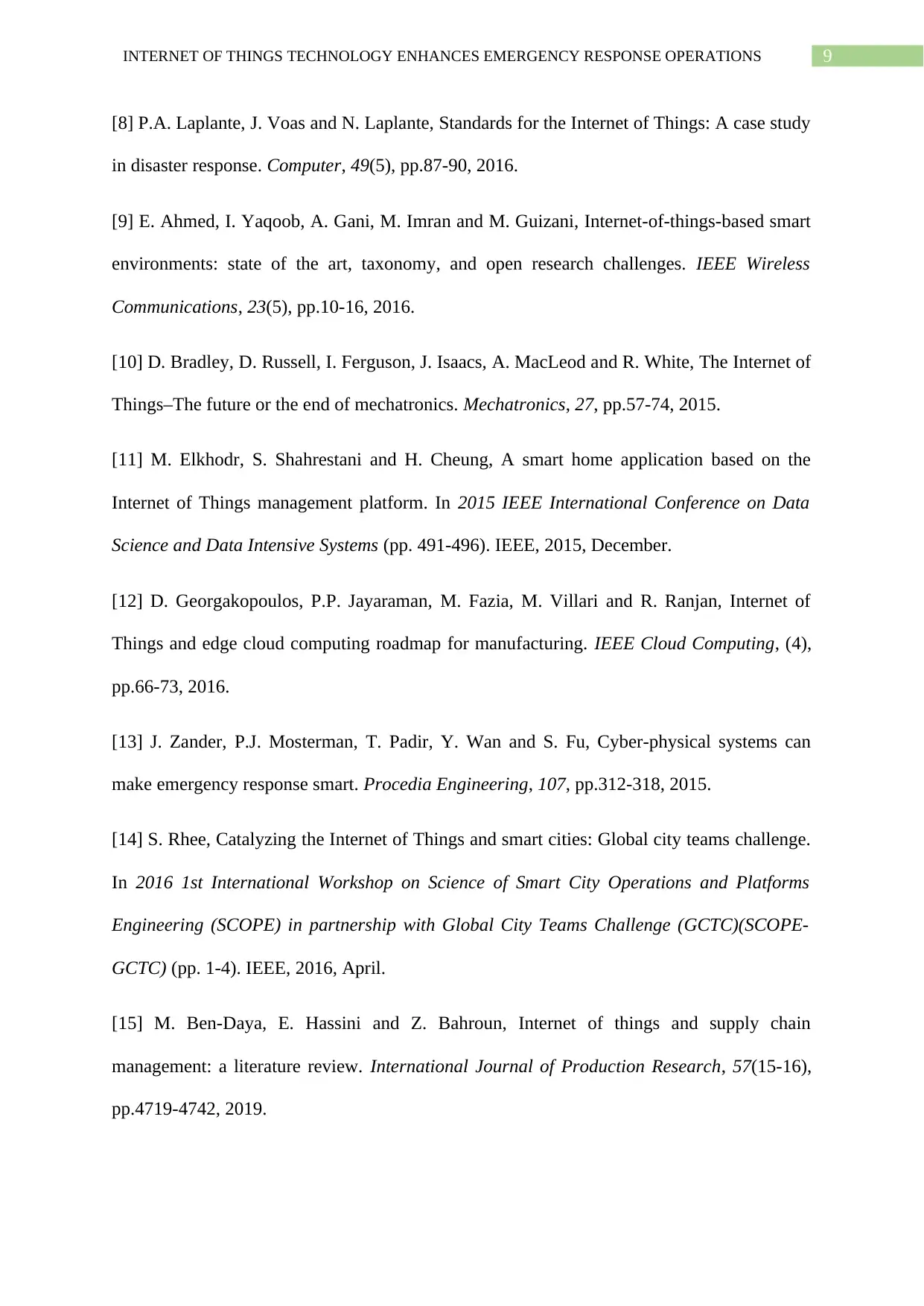
9INTERNET OF THINGS TECHNOLOGY ENHANCES EMERGENCY RESPONSE OPERATIONS
[8] P.A. Laplante, J. Voas and N. Laplante, Standards for the Internet of Things: A case study
in disaster response. Computer, 49(5), pp.87-90, 2016.
[9] E. Ahmed, I. Yaqoob, A. Gani, M. Imran and M. Guizani, Internet-of-things-based smart
environments: state of the art, taxonomy, and open research challenges. IEEE Wireless
Communications, 23(5), pp.10-16, 2016.
[10] D. Bradley, D. Russell, I. Ferguson, J. Isaacs, A. MacLeod and R. White, The Internet of
Things–The future or the end of mechatronics. Mechatronics, 27, pp.57-74, 2015.
[11] M. Elkhodr, S. Shahrestani and H. Cheung, A smart home application based on the
Internet of Things management platform. In 2015 IEEE International Conference on Data
Science and Data Intensive Systems (pp. 491-496). IEEE, 2015, December.
[12] D. Georgakopoulos, P.P. Jayaraman, M. Fazia, M. Villari and R. Ranjan, Internet of
Things and edge cloud computing roadmap for manufacturing. IEEE Cloud Computing, (4),
pp.66-73, 2016.
[13] J. Zander, P.J. Mosterman, T. Padir, Y. Wan and S. Fu, Cyber-physical systems can
make emergency response smart. Procedia Engineering, 107, pp.312-318, 2015.
[14] S. Rhee, Catalyzing the Internet of Things and smart cities: Global city teams challenge.
In 2016 1st International Workshop on Science of Smart City Operations and Platforms
Engineering (SCOPE) in partnership with Global City Teams Challenge (GCTC)(SCOPE-
GCTC) (pp. 1-4). IEEE, 2016, April.
[15] M. Ben-Daya, E. Hassini and Z. Bahroun, Internet of things and supply chain
management: a literature review. International Journal of Production Research, 57(15-16),
pp.4719-4742, 2019.
[8] P.A. Laplante, J. Voas and N. Laplante, Standards for the Internet of Things: A case study
in disaster response. Computer, 49(5), pp.87-90, 2016.
[9] E. Ahmed, I. Yaqoob, A. Gani, M. Imran and M. Guizani, Internet-of-things-based smart
environments: state of the art, taxonomy, and open research challenges. IEEE Wireless
Communications, 23(5), pp.10-16, 2016.
[10] D. Bradley, D. Russell, I. Ferguson, J. Isaacs, A. MacLeod and R. White, The Internet of
Things–The future or the end of mechatronics. Mechatronics, 27, pp.57-74, 2015.
[11] M. Elkhodr, S. Shahrestani and H. Cheung, A smart home application based on the
Internet of Things management platform. In 2015 IEEE International Conference on Data
Science and Data Intensive Systems (pp. 491-496). IEEE, 2015, December.
[12] D. Georgakopoulos, P.P. Jayaraman, M. Fazia, M. Villari and R. Ranjan, Internet of
Things and edge cloud computing roadmap for manufacturing. IEEE Cloud Computing, (4),
pp.66-73, 2016.
[13] J. Zander, P.J. Mosterman, T. Padir, Y. Wan and S. Fu, Cyber-physical systems can
make emergency response smart. Procedia Engineering, 107, pp.312-318, 2015.
[14] S. Rhee, Catalyzing the Internet of Things and smart cities: Global city teams challenge.
In 2016 1st International Workshop on Science of Smart City Operations and Platforms
Engineering (SCOPE) in partnership with Global City Teams Challenge (GCTC)(SCOPE-
GCTC) (pp. 1-4). IEEE, 2016, April.
[15] M. Ben-Daya, E. Hassini and Z. Bahroun, Internet of things and supply chain
management: a literature review. International Journal of Production Research, 57(15-16),
pp.4719-4742, 2019.
Paraphrase This Document
Need a fresh take? Get an instant paraphrase of this document with our AI Paraphraser
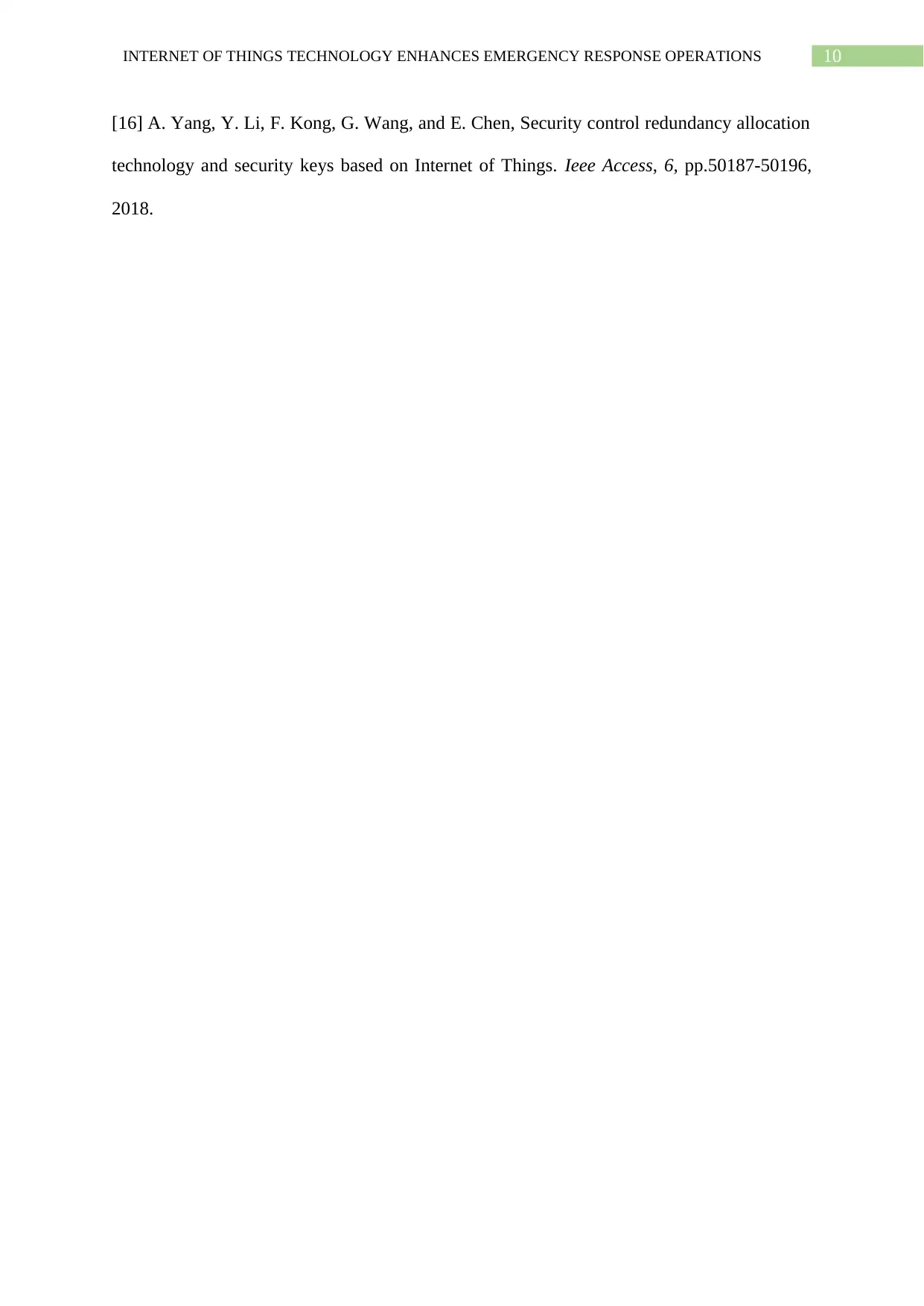
10INTERNET OF THINGS TECHNOLOGY ENHANCES EMERGENCY RESPONSE OPERATIONS
[16] A. Yang, Y. Li, F. Kong, G. Wang, and E. Chen, Security control redundancy allocation
technology and security keys based on Internet of Things. Ieee Access, 6, pp.50187-50196,
2018.
[16] A. Yang, Y. Li, F. Kong, G. Wang, and E. Chen, Security control redundancy allocation
technology and security keys based on Internet of Things. Ieee Access, 6, pp.50187-50196,
2018.
1 out of 11
Related Documents
Your All-in-One AI-Powered Toolkit for Academic Success.
+13062052269
info@desklib.com
Available 24*7 on WhatsApp / Email
![[object Object]](/_next/static/media/star-bottom.7253800d.svg)
Unlock your academic potential
Copyright © 2020–2025 A2Z Services. All Rights Reserved. Developed and managed by ZUCOL.





